人教版(2019)选择性必修 第三册Unit 3 Environmental Protection Video Time 课件(共34张PPT)
文档属性
| 名称 | 人教版(2019)选择性必修 第三册Unit 3 Environmental Protection Video Time 课件(共34张PPT) |  | |
| 格式 | pptx | ||
| 文件大小 | 31.5MB | ||
| 资源类型 | 教案 | ||
| 版本资源 | 人教版(2019) | ||
| 科目 | 英语 | ||
| 更新时间 | 2024-04-08 19:51:17 | ||
图片预览

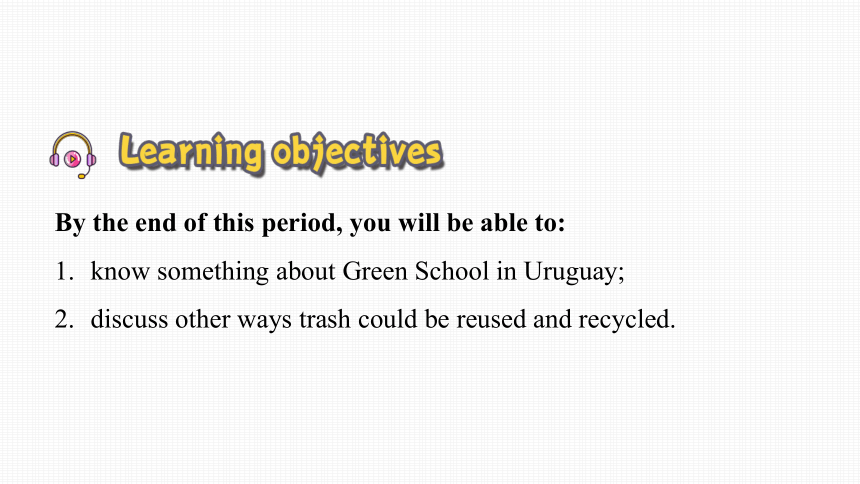

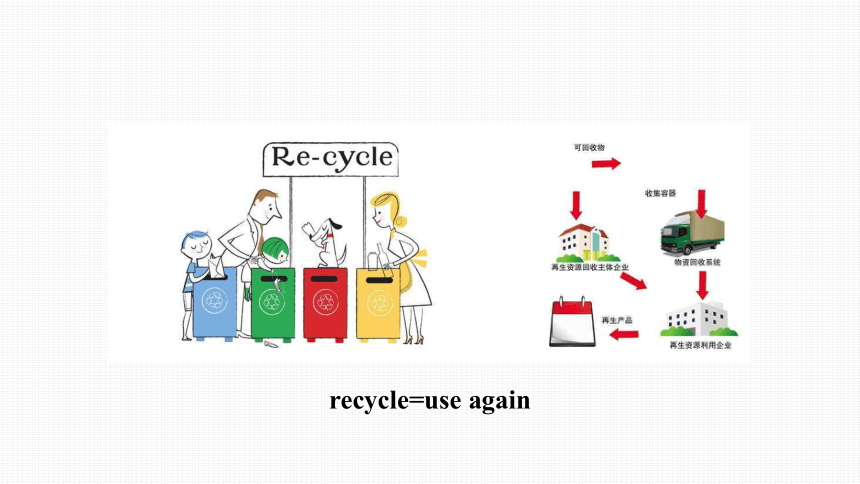
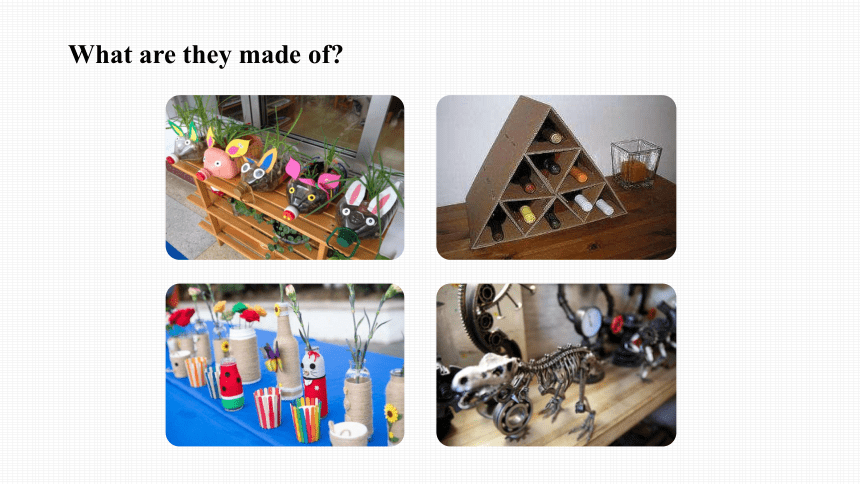

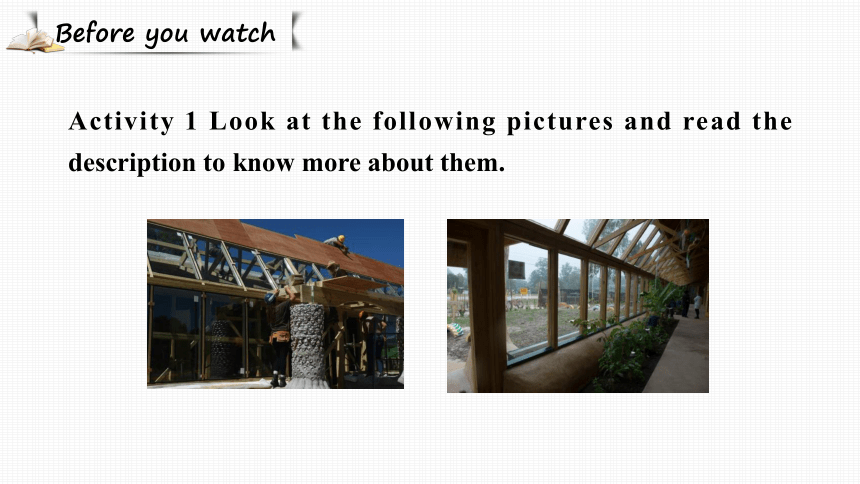

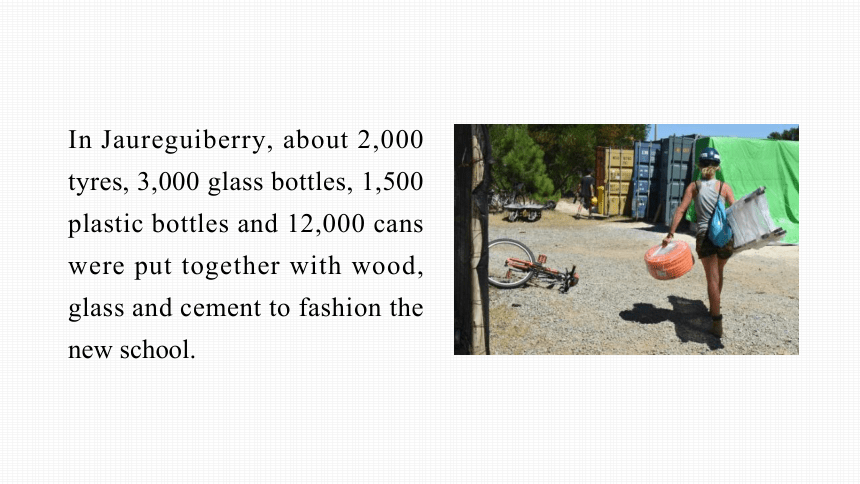
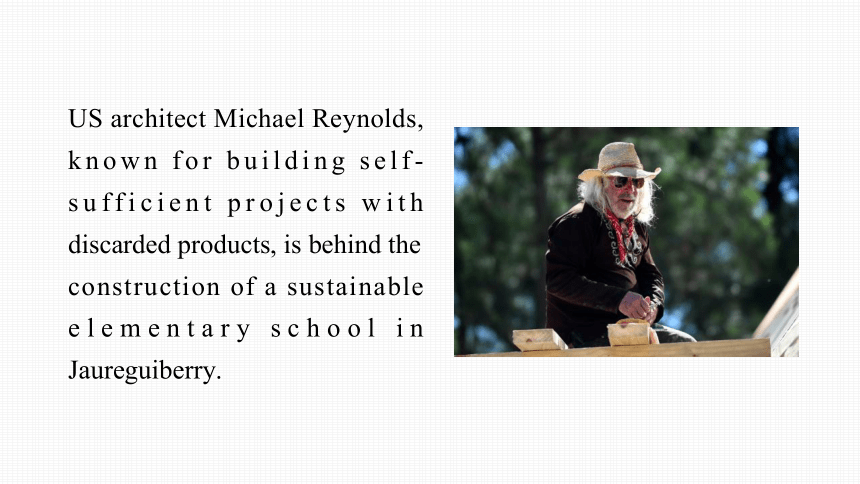
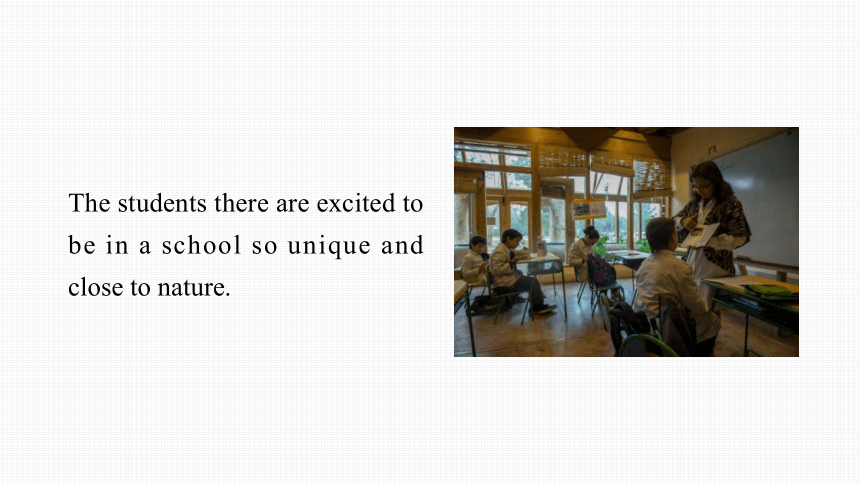
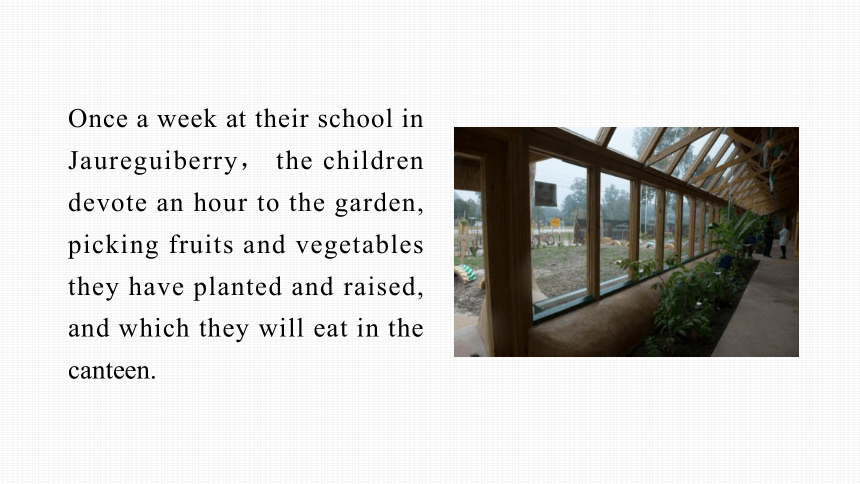
文档简介
(共34张PPT)
Unit 3
Environmental protection
Video Time
By the end of this period, you will be able to:
know something about Green School in Uruguay;
discuss other ways trash could be reused and recycled.
Lead-in
How do you deal with things you don’t use
Throw them away
Turn waste into “wealth”
recycle=use again
What are they made of
What can we do with a plastic bottle
grow flowers
pencil holders
a flower vase
art works
Before you watch
Activity 1 Look at the following pictures and read the description to know more about them.
Made of tyres and glass and plastic bottles, an elementary school in Jaureguiberry, east of Montevideo (蒙得维的亚:乌拉圭首都和最大城市), claims to be the first public school in Latin America that is totally green.
In Jaureguiberry, about 2,000 tyres, 3,000 glass bottles, 1,500 plastic bottles and 12,000 cans were put together with wood, glass and cement to fashion the new school.
US architect Michael Reynolds, known for building self-sufficient projects with discarded products, is behind the construction of a sustainable elementary school in Jaureguiberry.
The students there are excited to be in a school so unique and close to nature.
Once a week at their school in Jaureguiberry, the children devote an hour to the garden, picking fruits and vegetables they have planted and raised, and which they will eat in the canteen.
Green School in Uruguay
This video is about a green school in Uruguay that teaches its students about recycling, energy saving, and growing their own food. Built from recycled materials, the school produces no waste and is powered by solar panels.
Activity 2 Here are some photos from the video. In groups, use the following words and phrases to describe what is going on in the photos. Then discuss whether you think this school is “green” or not.
solar panels trash school reuse build
tin cans plants volunteers grow food collect
old car tyres learn children teach
While you watch
solar panels trash school reuse build
tin cans plants volunteers grow food collect
old car tyres learn children teach
Activity 1 Check your answers in Before You Watch.
These are tin cans that would usually be trash, but have been collected, perhaps to reuse them for something.
Volunteers are building part of the school.
This is part of the school that has been built using old car tyres.
There are plants. Students grow food inside the school.
This is a classroom where children are taught.
There are solar panels on the outside of the school building. These use energy from the sun to provide power for the school.
Activity 2 Watch the video and answer these questions.
1. Where is Uruguay
2. Why is the school “autonomous”
3. What nickname does the US architect Michael Reynolds call himself
4. Who else other than the students learn from the workshops
5. How does one student educate his mother about waste
1. Where is Uruguay
Uruguay is in South America.
2. Why is the school “autonomous”
The school is “autonomous” because it isn’t connected to any energy or water infrastructure.
3. What nickname does the US architect Michael Reynolds call himself
Michael Reynolds calls himself a “garbage warrior”.
4. Who else other than the students learn from the workshops
The teachers also learn from the workshops.
5. How does one student educate his mother about waste
One student educates his mother about waste by picking up any waste he finds on the way to and from school and disposing of it properly.
Read together
Narrator:A sunny winter’s day is great news for these Uruguayan children. As pupils of South America’s first sustainable school, they study in a building heated only using solar panels. On top of the normal school program, they learn about recycling, energy saving, and growing their own food.
Francesco Fassina:The school is an autonomous building in the sense that it isn’t connected to any energy infrastructure for water or anything. It’s sustainable in the way it functions; totally autonomous and it works thanks to its connection with nature—the sun and the rain.
Narrator: The building was funded by a local NGO and a detergent company, and designed by US architect Michael Reynolds, a self-professed “garbage warrior” who's devoted his career to building self-sufficient structures out of recyclable material.
Michael Reynolds:People called me an idiot, uh,building with garbage, what a fool, you’re a disgrace to the architectural community, uh,you know. I was trying to contain sewage and treat it and do all of these things that architects didn't do.
Narrator: The 39 students, some just starting pre-school and others in their final year before university learn it's possible to live in a building that produces no waste. NGO volunteers organize regular workshops and sustainability for pupils and teachers too.
Alicia Alvarez:Little by little, we're becoming qualified. In fact, we're being trained by them. We're being trained to learn how the school works, how to maintain it so that the systems don't deteriorate.
Narrator: Some of the children have even started educating their parents.
Danila Mendez:Everyday, we walk here and he finds glass in the sand or plastic or something, and he picks it up. He says, “I’m keeping this to throw it away.” He doesn’t leave it there. He picks it up and he throws it away in the right place.
Narrator: For these little garbage warriors, saving the planet has become an integral part of their homework.
1. Do you know any similar projects in your city or country How do people reuse and recycle trash to create new things and technologies
In my country some people collect plastic bottles and use them to make furniture for gardens and parks, such as benches and play ground equipment.
After you watch
windows and doors of old buildings that have been pulled down; an old boat; rocks; old glass bottles
a house
old clothes, especially old jeans
bags
iron and other materials from old cars
beautiful art pieces
Reuse and recycle
2. In small groups, discuss other ways trash could be reused and recycled. What things could you make What kinds of trash could you use
Trash can be reused in many ways. We could make plant pots for the school garden from plastic bottle sand pots. We can cut off the tops of the bottles, put holes in the bottom, then fill with soil and a plant. Then we can hang them on a wall to make a wall garden.
Are there any places like this Green School in China In what way are they similar How are they different
Search for information through the Internet and complete a composition.
Homework
Unit 3
Environmental protection
Video Time
By the end of this period, you will be able to:
know something about Green School in Uruguay;
discuss other ways trash could be reused and recycled.
Lead-in
How do you deal with things you don’t use
Throw them away
Turn waste into “wealth”
recycle=use again
What are they made of
What can we do with a plastic bottle
grow flowers
pencil holders
a flower vase
art works
Before you watch
Activity 1 Look at the following pictures and read the description to know more about them.
Made of tyres and glass and plastic bottles, an elementary school in Jaureguiberry, east of Montevideo (蒙得维的亚:乌拉圭首都和最大城市), claims to be the first public school in Latin America that is totally green.
In Jaureguiberry, about 2,000 tyres, 3,000 glass bottles, 1,500 plastic bottles and 12,000 cans were put together with wood, glass and cement to fashion the new school.
US architect Michael Reynolds, known for building self-sufficient projects with discarded products, is behind the construction of a sustainable elementary school in Jaureguiberry.
The students there are excited to be in a school so unique and close to nature.
Once a week at their school in Jaureguiberry, the children devote an hour to the garden, picking fruits and vegetables they have planted and raised, and which they will eat in the canteen.
Green School in Uruguay
This video is about a green school in Uruguay that teaches its students about recycling, energy saving, and growing their own food. Built from recycled materials, the school produces no waste and is powered by solar panels.
Activity 2 Here are some photos from the video. In groups, use the following words and phrases to describe what is going on in the photos. Then discuss whether you think this school is “green” or not.
solar panels trash school reuse build
tin cans plants volunteers grow food collect
old car tyres learn children teach
While you watch
solar panels trash school reuse build
tin cans plants volunteers grow food collect
old car tyres learn children teach
Activity 1 Check your answers in Before You Watch.
These are tin cans that would usually be trash, but have been collected, perhaps to reuse them for something.
Volunteers are building part of the school.
This is part of the school that has been built using old car tyres.
There are plants. Students grow food inside the school.
This is a classroom where children are taught.
There are solar panels on the outside of the school building. These use energy from the sun to provide power for the school.
Activity 2 Watch the video and answer these questions.
1. Where is Uruguay
2. Why is the school “autonomous”
3. What nickname does the US architect Michael Reynolds call himself
4. Who else other than the students learn from the workshops
5. How does one student educate his mother about waste
1. Where is Uruguay
Uruguay is in South America.
2. Why is the school “autonomous”
The school is “autonomous” because it isn’t connected to any energy or water infrastructure.
3. What nickname does the US architect Michael Reynolds call himself
Michael Reynolds calls himself a “garbage warrior”.
4. Who else other than the students learn from the workshops
The teachers also learn from the workshops.
5. How does one student educate his mother about waste
One student educates his mother about waste by picking up any waste he finds on the way to and from school and disposing of it properly.
Read together
Narrator:A sunny winter’s day is great news for these Uruguayan children. As pupils of South America’s first sustainable school, they study in a building heated only using solar panels. On top of the normal school program, they learn about recycling, energy saving, and growing their own food.
Francesco Fassina:The school is an autonomous building in the sense that it isn’t connected to any energy infrastructure for water or anything. It’s sustainable in the way it functions; totally autonomous and it works thanks to its connection with nature—the sun and the rain.
Narrator: The building was funded by a local NGO and a detergent company, and designed by US architect Michael Reynolds, a self-professed “garbage warrior” who's devoted his career to building self-sufficient structures out of recyclable material.
Michael Reynolds:People called me an idiot, uh,building with garbage, what a fool, you’re a disgrace to the architectural community, uh,you know. I was trying to contain sewage and treat it and do all of these things that architects didn't do.
Narrator: The 39 students, some just starting pre-school and others in their final year before university learn it's possible to live in a building that produces no waste. NGO volunteers organize regular workshops and sustainability for pupils and teachers too.
Alicia Alvarez:Little by little, we're becoming qualified. In fact, we're being trained by them. We're being trained to learn how the school works, how to maintain it so that the systems don't deteriorate.
Narrator: Some of the children have even started educating their parents.
Danila Mendez:Everyday, we walk here and he finds glass in the sand or plastic or something, and he picks it up. He says, “I’m keeping this to throw it away.” He doesn’t leave it there. He picks it up and he throws it away in the right place.
Narrator: For these little garbage warriors, saving the planet has become an integral part of their homework.
1. Do you know any similar projects in your city or country How do people reuse and recycle trash to create new things and technologies
In my country some people collect plastic bottles and use them to make furniture for gardens and parks, such as benches and play ground equipment.
After you watch
windows and doors of old buildings that have been pulled down; an old boat; rocks; old glass bottles
a house
old clothes, especially old jeans
bags
iron and other materials from old cars
beautiful art pieces
Reuse and recycle
2. In small groups, discuss other ways trash could be reused and recycled. What things could you make What kinds of trash could you use
Trash can be reused in many ways. We could make plant pots for the school garden from plastic bottle sand pots. We can cut off the tops of the bottles, put holes in the bottom, then fill with soil and a plant. Then we can hang them on a wall to make a wall garden.
Are there any places like this Green School in China In what way are they similar How are they different
Search for information through the Internet and complete a composition.
Homework
